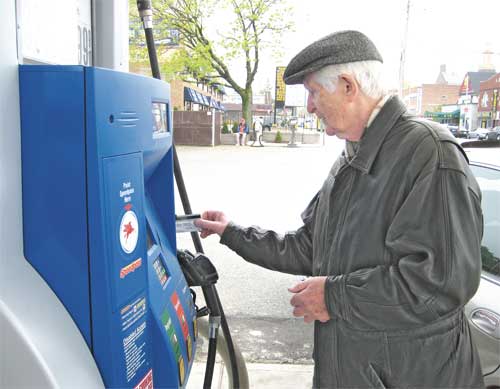By The TimesLedger Staff
The slowdown in the U.S. economy has trickled down to Queens, where the unemployment rate is rising, lines at food pantries are swelling and more residents are using half of their paychecks on rent.
With gas prices teetering at $4 a gallon for regular unleaded and food costs increasing, Queens residents are also being forced to cut back on luxuries and use more public transportation.
“It goes up and never comes down,” said Bayside resident Andrew Garcdynski as he filled up his Nissan Altima at the Mobil station on Northern Boulevard near Bell Boulevard, where gas was $3.95 a gallon Friday.
Motorist Kwang Hee Kwon, who drives a BMW SUV to work in Flushing, said his wife plans to sell her Honda to save money. He said it costs $65 to fill up his tank, which lasts four days.
“Gas prices affect all our lives,” he said.
The rise in gas is also changing how city residents commute.
Aaron Donovan, an MTA spokesman, said ridership was up across-the-board in the first quarter of 2008 compared to the same period last year.
“Gasoline prices are certainly contributing to this trend, but they are not the only factor,” he said.
A large portion of the borough's immigrant population is employed in sectors where the downturn in the economy is being felt the most, according to Carmen Gutierrez, an immigration specialist with the Queens Community House in Jackson Heights.
“Many of our members in the community, they work in construction, painting companies that are being hit since the real estate market is doing badly now,” Gutierrez said. “That contributes to a lot of headaches for them.”
The borough's unemployment rate rose 0.3 percent from February to March from 3.9 percent in February to 4.2 percent in March, according to state Labor Department statistics.
Queens shoppers are also seeing prices of consumer goods jump citywide. The price consumer index for the city in March at 233.1 represents a 3.8 percent increase from the same time last year, the state data showed.
The tough times are causing more homeowners to go into foreclosure, where Queens leads the rest of the city. Those who have lost their homes are finding it more difficult to find a bed at a city shelter.
Since last year the city's Homeless Services Department has seen a decline in available beds. There are about 800 fewer beds at private and city-operated shelters than there were at this time last year, according to the agency's 2008 Critical Activities Report.
Like homeowners, Queens renters are also feeling the pinch.
U.S. Rep. Anthony Weiner (D-Forest Hills) said a study he commissioned found that 110,000 borough renters, or 28 percent of renters, spent half or more of their income on rent in 2006, the most recent year statistics were recorded.
“If New York City is going to continue as the middle-class capital of the world, then we need to have places where middle-class families can afford to live,” he said.
A food pantry run by the First Presbyterian Church of Jamaica has seen demand soar over the past few months. The pantry's director said patronage shows no signs of slowing down.
“I don't know if things will alleviate. You've got the mortgage crisis, rising gas prices, rising grocery prices. All of it has come to signal what are rough times ahead,” said the Rev. Alberta Mendenhall, director of the food pantry.
“The majority who come to us are the working poor and those who lost their jobs,” she said. “There are those who are homeless, there are those who are immigrants, but there are also the working poor who need to find ways to make ends meet.”































